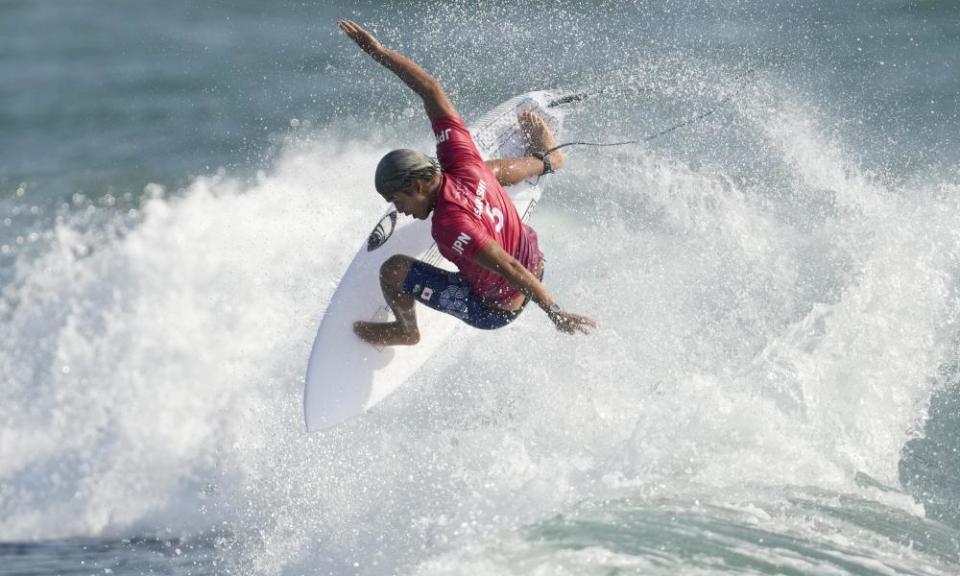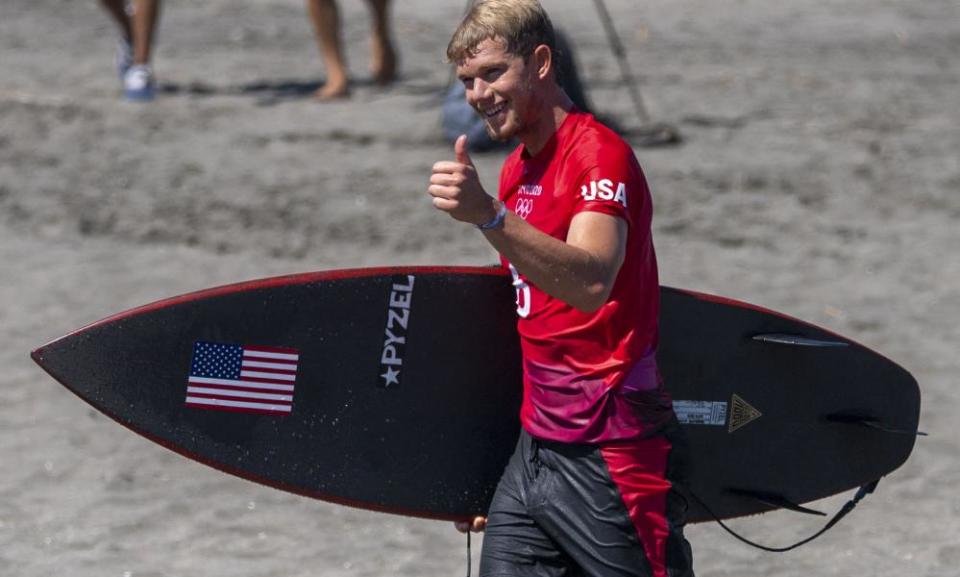Surfing glides gracefully into Olympics as Igarashi comes home

There was a little bit of Olympic history made at Tsurigasaki beach early on Sunday morning when four surfers paddled out into the Pacific for the start of the Games’ very first surfing competition. No one was exactly sure who caught the first wave, maybe the Brazilian, Italo Ferreira.
“It was a terrible start,” he said with a laugh, “I made two turns and fell”. He won the heat anyway, so didn’t mind. Nor did anyone watching. From where we were sitting back on the glistening golden-brown sand, looking out at the blue-green sea and pale sky, the pressing question about Olympic surfing was why the International Olympic Committee took so long coming around to it.
Related: Wave of success: staycations and Olympics drive surfing boom
They say Duke Kahanamoku, the Hawaiian who first popularised surfing back in the early years of the 20th century, told the IOC they ought to include it during the Stockholm Games in 1912, when he won the first of his three Olympic gold medals in freestyle swimming. The International Surfing Association has been lobbying the IOC since 1995. It was only when Thomas Bach was elected IOC president in 2013 and decided the Games needed more youth sports that the ISA started to make headway. The surfers here were genuinely thrilled to be given the opportunity.
“I was so nervous I felt a bit sick,” said Owen Wright. “That was insane,” said Leandro Usuna. “I’m so stoked,” said Ferreira. Unlike the rest of us, they have licence to use as many of the cliches as they want to. “The average guy has always perceived surfing as a stunt because of movies like Big Wednesday or Point Break,” explained Italy’s Leonardo Fioravanti, “but for years now, if you want to compete at an international level you have to be super fit, a real athlete.” I nodded when I read that, and discretely crossed out all the bodacious notes about Patrick Swayze off my pad.
“The Olympics serves this purpose too,” Fioravanti explained, “to help these people understand our sport better.” So: there were 40 of the world’s best surfers here; 20 women, and 20 men, all split into seeded groups of four, competing in five 30-minute heats. The top two went straight through, then there was a repechage, to be followed by a third round, quarters, semis, and finals.
They’re free to catch as many waves as they like, but only their best two count. They’re given an average score out of 10 by five judges who look at “the commitment and degree of difficulty”, “innovative and progressive manoeuvres”, “combination of major manoeuvres”, “variety of manoeuvres” and “speed, power and flow”.
If the sport has a barrier for a mainstream audience it’s in the differences between good, better, and best, and the subjective judgments involved in weighing it all up. But even so, it’s startling just to watch them bob like otters, jockeying for position and right of way, then all of a sudden pop up, and start to speed and cut and slice and leap and twist across the length of the wave. They make the impossibly difficult look implausibly easy. And, of course, most importantly for the IOC, it plays brilliantly on TV.
The sport has more to offer the Games than slow-mos, though. “We exist outside of competitions,” said the ISA president, Fernando Aguerre, last week. “You can’t be a boxer or a fencer if you don’t box or do fencing against somebody. But everyone can be a surfer without competing. This is a sport you do on your own.
“The ocean is free. It doesn’t belong to anyone. No one can buy it. Nobody can sell it. Nobody can charge you. You can be Bill Gates’ son or the janitor’s son, black or white, gay or straight, male or female, young or old, fat or skinny. Nobody cares. The ocean doesn’t care.”
Download the Guardian app from the iOS App Store on iPhones or the Google Play store on Android phones by searching for 'The Guardian'.
If you already have the Guardian app, make sure you’re on the most recent version.
In the Guardian app, tap the yellow button at the bottom right, then go to Settings (the gear icon), then Notifications.
Turn on sport notifications.
Away from the Olympic competition, all along the shore running down to the far mountains, people were making Aguerre’s point for him, families and kids in the water, weekenders body-boarding and surfing. It was another of the strange ironies of these Games that the only bit of Tsurigasaki beach which was empty was the patch set aside for the spectators of the Olympic competition.
It is a slow, sleepy, little town, with a genuine surfing community. Most of the Japanese competitors learned here. “There’s always just been a dirt road and now all of a sudden you have pretty much our own Olympic Village for surfers,” said Kanoa Igarashi.

He grew up in the US but his father was one of the first people to surf the beach, back in the 60s. “He and his friends discovered that wave. They climbed through fences and hiked through the grass to find this wave, and they called it the Dojo, and it was their little secret spot.”
Igarashi’s father moved the family to California because he wanted Kanoa and his brother Keanu (ahem) to grow up in a surfing community. Now Igarashi is back, surfing for Japan. “It’s definitely a very special connection for him – a wave that he discovered is where his son will compete at the Olympics for the first time. It’s such a crazy circle.”
Igarashi is one of the favourites for the men’s competition, along with Ferreira and the USA’s John John Florence. Most reckon the women’s event is between the USA’s Carissa Moore and the two Australians, Stephanie Gilmore and Sally Fitzgibbons.
They all made it through to the third round, although Florence had to do it through the repechage. He struggled on the small waves, which Igarashi says best suit tight, technical surfing. Regular fans were disappointed the swell wasn’t bigger, but it may be soon. There is a storm brewing off shore, and the promise of bigger waves. With them, there’ll be more peril – physical for the athletes, existential for the rest of us, since we face the threat that we’ll be left regretting our life choices.

 Yahoo Finance
Yahoo Finance 